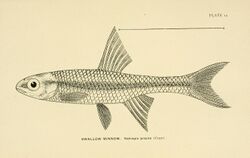Biology:Swallowtail shiner
| Swallowtail shiner | |
|---|---|

| |
| Drawing of Notropis procne | |
| Scientific classification | |
| Domain: | Eukaryota |
| Kingdom: | Animalia |
| Phylum: | Chordata |
| Class: | Actinopterygii |
| Order: | Cypriniformes |
| Family: | Cyprinidae |
| Subfamily: | Leuciscinae |
| Clade: | Pogonichthyinae |
| Genus: | Notropis |
| Species: | N. procne
|
| Binomial name | |
| Notropis procne (Cope, 1865)
| |
| Synonyms | |
|
Hybognathus procne Cope, 1865 | |
The swallowtail shiner (Notropis procne) is a North American species of freshwater fish in the family Cyprinidae. It has a slender and long body of about 40–55 millimetres (1.6–2.2 in). The shiner has a pale yellow back with a blue stripe on its silver side. It also has a silvery white belly. Its fins are yellowish and it has a dorsal fin originating above the back half of the pelvic fin base and a tail fin with a black spot at its base. When viewed from above, two pigmented stripes are visible near the dorsal fin: one predorsally and the postdorsally.[2]:880 Its snout is either slightly pointed or slightly rounded. The swallowtail shiner lives in warm creeks and in river pools.
It is known to live in Atlantic drainages from New York to South Carolina. It may have been introduced to the New River system in Virginia, although it is possible that it is native there.[3] It may have spread via canals into tributaries of Lake Ontario.[3] It is often found near plants. The shiner eats insects, worms, mites, microcrustaceans, and algae. Juvenile shiners mature after a year and spawn from mid-May to July when the water reaches a temperature of 25.6 °C (78.1 °F). Fecundity is unknown in this species and it breeds well in aquariums. It is similar to the closely related Cape Fear shiner and sand shiner.
Taxonomy
There are two subspecies of swallowtail shiner:[4] Notropis procne procne[5] and N. procne longiceps (Cope, 1868).[6] The nominate subspecies is found in the Delaware River and Susquehanna Rivers south to the James River in Virginia. N. procne longiceps is found from the Roanoke River in Virginia to the Santee River in South Carolina.[7]
References
- ↑ NatureServe (2013). "Notropis procne". IUCN Red List of Threatened Species 2013: e.T202320A18230300. doi:10.2305/IUCN.UK.2013-1.RLTS.T202320A18230300.en. https://www.iucnredlist.org/species/202320/18230300. Retrieved 13 November 2021.
- ↑ Warren Jr., Melvin L.; Burr, Brooks M.; Grady, James M. (1994). "Notropis albizonatus, a New Cyprinid Fish Endemic to the Tennessee and Cumberland River Drainages, with a Phylogeny of the Notropis procne Species Group". Copeia 1994 (4): 868–886. doi:10.2307/1446710.
- ↑ 3.0 3.1 Nico, Leo; Fuller, Pam (6 July 2000). "Notropis procne (Swallowtail Shiner)". Gainesville, Florida: U.S. Geological Survey. https://nas.er.usgs.gov/queries/factsheet.aspx?SpeciesID=607.
- ↑ "Notropis procne". Integrated Taxonomic Information System. https://www.itis.gov/servlet/SingleRpt/SingleRpt?search_topic=TSN&search_value=163407.
- ↑ "Notropis procne procne (Cope, 1865)". Integrated Taxonomic Information System. https://www.itis.gov/servlet/SingleRpt/SingleRpt?search_topic=TSN&search_value=163408.
- ↑ "Notropis procne longiceps (Cope, 1868)". Integrated Taxonomic Information System. https://www.itis.gov/servlet/SingleRpt/SingleRpt?search_topic=TSN&search_value=690346.
- ↑ Smith, C. Lavett (2006). "Swallowtail shiner". Department of Natural Resources, Cornell University and the New York State Department of Environmental Conservation. http://www2.dnr.cornell.edu/cek7/nyfish/Cyprinidae/swallowtail_shiner.html.
- "Swallowtail Shiner, Notropis procne". The Virtual Aquarium. http://www.cnr.vt.edu/efish/families/swallowtail.html.
Wikidata ☰ Q3755518 entry
 |


